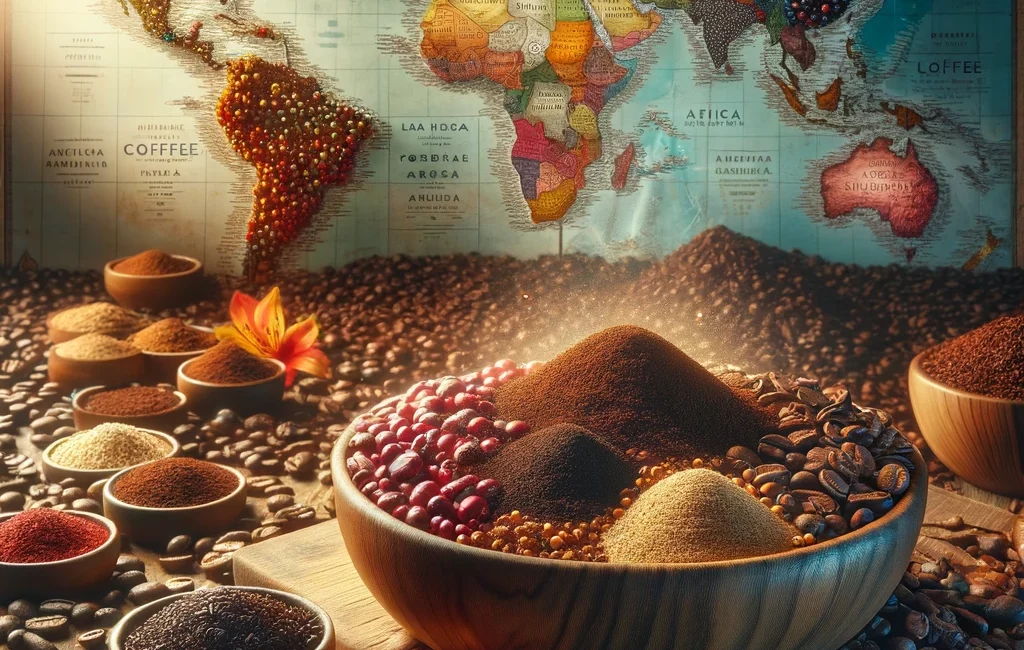
We often get questions about how we go about deciding the right beans for a coffee blend. This is a great question and it unveils one of the great joys of being a roaster. It is akin to being a chef creating the perfect recipe, or a chemist find the ultimate solution, and no less thrilling than explorers finding a new path that leads to a breath taking vista. Yeah, we love this stuff.
As with any great undertaking it pays to learn a bit first. Below, we‘ll share the knowledge we have and you‘ll be building your own blends in no time.

1. Understanding Coffee Bean Varieties
Coffee beans are not just a commodity; they are a canvas of flavors. They come in different varieties, each with its unique profile. The two primary species are Arabica and Robusta, with Arabica being more favored for its delicate and nuanced flavors. Within these species, there are multiple varieties, each influenced by the region’s climate, altitude, and soil.
2. The Role of Geography in Flavor
The geography of where a coffee bean is grown plays a crucial role in its flavor profile. Beans from Latin America often have bright, lively flavors, while African beans are known for their fruity and floral notes. Asian coffee, on the other hand, tends to have earthier, fuller bodies. Understanding these regional characteristics helps in selecting beans that will harmonize in a blend.
3. Ethical and Sustainable Sourcing
Sourcing beans is not just about flavor. Ethical and sustainable practices are paramount. Look for beans that are fair trade and organically grown. This ensures that farmers are fairly compensated, and sustainable practices are used in cultivation, benefiting both the environment and the communities.
4. The Importance of Freshness
Freshness is key to the quality of your coffee. Beans should be sourced from roasters who provide information about the harvest and roast dates. Fresher beans mean more vibrant flavors, essential for a perfect blend.
5. Experimenting with Blends
Creating the perfect blend is an art. It involves experimenting with different beans and ratios. Start with two or three varieties and adjust the proportions based on your taste preference. Consider how the flavors complement each other. For example, combining a bright Latin American bean with a fruity African bean can create a harmonious balance.
6. Tasting and Refining Your Coffee Blend
Tasting is an integral part of the blending process. Pay attention to the body, acidity, sweetness, and aftertaste. Take notes on what you like and what you don‘t. This will guide you in refining your blend.
7. Sharing Your Perfect Coffee Blend
Once you‘ve created your blend, share it with friends and fellow coffee enthusiasts. Get feedback and make adjustments if necessary. Remember, the perfect blend is not just about the beans, but also about the experience and joy it brings.
Conclusion: A Journey of Discovery
Sourcing beans for the perfect coffee blend is a journey of discovery. It requires patience, experimentation, and a deep appreciation for the nuances of coffee. Embrace this journey, and you‘ll not only find your perfect blend but also gain a deeper understanding and appreciation for this beloved beverage. Please check out our favorite house blend today.
Stay tuned for more coffee insights and tips on our blog. Happy brewing!
Pro Tip
You can get your own green beans and roast them, or a great alternative is sourcing a few bags of roasted beans. Take 50% of one, 25% of another, and 25% of a third. Try it out, adjust the amounts, and try again. Find that combination that makes you happy and savor the results of your alchemy.


